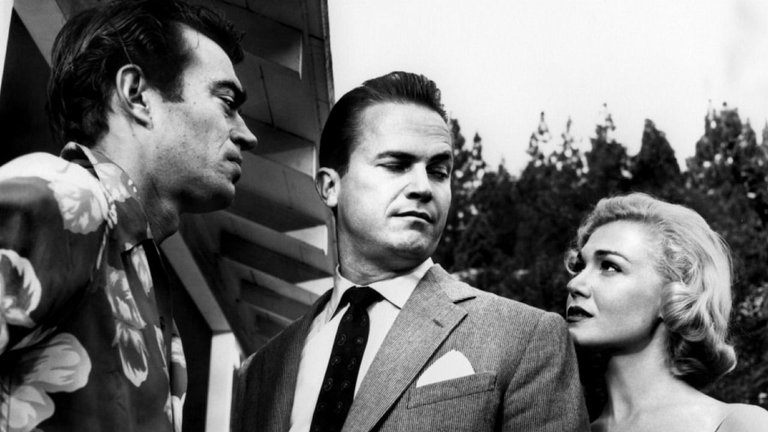
The genre of film noir has long been a subject of intense debate among cinephiles and film scholars. What constitutes this distinctively dark and moody cinematic style is a topic of heated discussion, and even the film often hailed as a classic of the genre and one of the most influential films of 1950s Hollywood, Kiss Me Deadly, directed by Robert Aldrich, is not immune to this critical scrutiny.
It is based on Mickey Spillane's 1952 novel of the same name, the sixth in the series featuring the violent private detective Mike Hammer. The plot begins one night on the road when Hammer (played by Ralph Meeker) picks up distraught hitch-hiking woman Christina Bailey (played by Cloris Leachman) and agrees to drive her to Los Angeles. Before reaching destination, both are captured by thugs who torture Christina to death and attempt to cover their crime by staging car accident. Hammer miraculously survives and, after recovery, gets determined to find people responsible, and his investigation leads him to complex plot involving not only common criminals, but scientists and whole variety of characters trying to get their hands on mysterious objects Hammer’s secretary and part-time girlfriend Velda Wakeman (played by Maxine Cooper) calls “great whatsit”.
The film's protagonist represents both a continuation and departure from the iconic private detectives of Hollywood film noir classics. Unlike the likes of Sam Spade or Philip Marlowe, Hammer relies less on brain and more on brawn to get ahead, using violence not only in self-defense but also to gain information. This makes Hammer appear more like a bully than a hero. But Hammer is not even the most moral character – he is a petty detective specializing in divorce cases whose modus operandi involves something akin to blackmail, with Velda being all but pimped to potential customers/marks. Hammer is both seduced and seduces women, and, as such, looks promiscuous.
In this dark tale, the only way for the protagonist to regain some of the audience's sympathy was to make all other characters much worse. Kiss Me Deadly features some rather despicable or frightening villains, and this, in turn, makes the film much darker and nihilistic than most film noirs. The scriptwriter, A. Z. Bezzerides, made the film even darker by changing much of the plot from Spillane's novel, replacing drugs as the MacGuffin and ordinary criminals as villains with nuclear secrets and spies. This was quite in line with the general sentiments of the time, marked by Cold War paranoia and fears of nuclear annihilation. The latter provided one of the most memorable endings in the history of 1950s Hollywood, which, due to its apocalyptic and somewhat ambiguous nature, often made Kiss Me Deadly listed as a science fiction film. This ending was referenced in films like Raiders of the Lost Ark, Repo Man, and Pulp Fiction.
Made during a time when the infamous Hays Code was still enforced, Kiss Me Deadly was trying to push the envelope in terms of eroticism and violence. Three major female characters appear barefoot and apparently naked under coats or bathrobes, and people are killed in rather cruel and unpleasant ways. Although the Hays Office didn't complain, some politicians criticized the film for "corrupting youth" or even mistook the film's dark nihilism for subversive left-wing propaganda. This forced Aldrich to defend the film, which only helped with publicity. It was, however, the French critics, who would later lead the New Wave movement, who praised the film as a masterpiece and thus guaranteed its future cult status.
The cast is solid, with relatively unknown Ralph Meeker (who would later have successful career on television) delivering a competent performance, which is nevertheless overshadowed by a small army of character actors playing colourful personalities Hammer meets during his investigation. Cloris Leachman, who would decades later become one of the more recognisable character actresses, has a great opening, matched only by Gaby Rodgers as her character's increasingly manic room mate. Rodgers, for whom this would be her last film role before dedicating her career to theatre, is especially effective nearthe film's ending.
Kiss Me Deadly is a very good and memorable film, but far from perfect. Its plot, however, is convoluted and hard to follow, and some crucial scenes leave many questions unanswered. The beginning, with opening titles that are being rolled in reverse, accompanied by Nat King Cole's song "I'd Rather Have the Blues (Than What I've Got)" and Christina's heavy panting, looks a little bit too "artsy" and "clever." Nevertheless, even with these flaws, Kiss Me Deadly deserves its status in the annals of 20th-century cinema. It is a testament to the power of film noir and its ability to captivate audiences.
RATING: 7/10 (+++)
Blog in Croatian https://draxblog.com
Blog in English https://draxreview.wordpress.com/
InLeo blog https://inleo.io/@drax.leo
Hiveonboard: https://hiveonboard.com?ref=drax
Rising Star game: https://www.risingstargame.com?referrer=drax
1Inch: https://1inch.exchange/#/r/0x83823d8CCB74F828148258BB4457642124b1328e
BTC donations: 1EWxiMiP6iiG9rger3NuUSd6HByaxQWafG
ETH donations: 0xB305F144323b99e6f8b1d66f5D7DE78B498C32A7
BCH donations: qpvxw0jax79lhmvlgcldkzpqanf03r9cjv8y6gtmk9
Posted Using InLeo Alpha